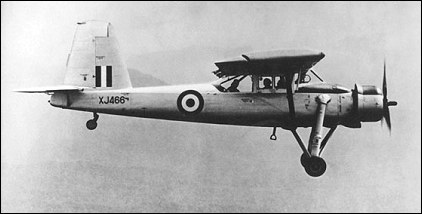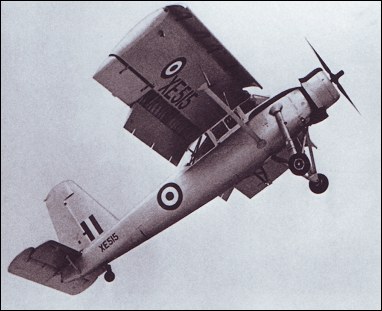|
| The Pioneer began life as a three-seat light military communications aircraft built to Specification A.4/45 and powered by a 179kW de Havilland Gipsy Queen 34 engine. The original military requirement failed to materialise and so the basic design was developed into a civil light transport aircraft as the (Prestwick) Pioneer.
On 5 May 1950 the first prototype of the 387kW Leonides-powered Pioneer II flew. It was selected for service as a five-seat communications and casualty-evacuation (one stretcher and an attendant) aircraft for the RAF and production CC.1s were flown from mid-1953. By March 1960 a total of 53 Pioneer IIs had been delivered, most to the RAF but five to the Royal Ceylonese Air Force and others to Iran and Malaya.
| CREW | 1 |
| PASSENGERS | 4 |
| ENGINE | 1 x 520hp Alvis Leonides 501/4 9-cylinder radial engine |
| WEIGHTS |
| Take-off weight | 2630 kg | 5798 lb |
| DIMENSIONS |
| Wingspan | 15.16 m | 50 ft 9 in |
| Length | 10.59 m | 35 ft 9 in |
| Height | 3.12 m | 10 ft 3 in |
| PERFORMANCE |
| Max. speed | 195 km/h | 121 mph |
| Ceiling | 7010 m | 23000 ft |
| Range | 690 km | 429 miles |
| ron huntley, e-mail, 04.01.2010 22:46 i was at an airshow at RAF Colerne in the late fifties and a single pin was going to do his display . there was a stiff wind blowing ,the aircraft reved is engine against the brakes raised the tail without moving released the brakes and rolled about a yard and was airbourne. very impressive.i have been a fan ever since of the pioneer reply | | Paul Glover, e-mail, 14.11.2009 00:46 I was a radio mechanic(air) on 845 squadron on hms bulwark 67 /68 in the far east. I was on the flight deck when a Sin Pin carried out deck landings - amazing aircraft. reply | | Chris Applegarth, e-mail, 15.09.2009 01:24 My father George Applegarth flew the single pin in the uk and far east. I have lots of photos and some film of the aircrat, including the landings on HMS Bulwark in the Sumatra Straits. I'd be happy to share my info and would like to hear from anyone who flew with my father or the single pin. reply | | Ashley GS Lim, e-mail, 11.08.2009 20:55 I believe that I have some old photos of the single pin, pilot's handbook, some old data about the old forts, the approaches to the landing strips and discriptions of the strips e.g. Fort Tapau, Fort Kemar, Fort Legap, Fort Betau anhd Fort Chabai. Its somewhere in my attic. At the moment, I'm too lazy to go searching for these documents unless someone REALLY wants them. I also remember the approaches to landing and the takeoff techniques and departure path of these Forts. Also the approach for parachute drop to Fort Betis. Ash reply | |
| | Roy Follows, e-mail, 23.06.2009 12:05 At present I'm writng a book about the little known twelve official jungle forts, that played an important role in defeating the communists in Malaysia. I my self was the commander of Fort Brooke ,but because of it being in a mountainous area it was one of the two forts that had no run way .I'm interested in photographs of jungle Forts and Pioneers at the forts etc. Thanks Roy. reply | | siva, e-mail, 07.06.2009 18:51 Hi Ashley, Great to hear from you old boy......
BTW, Robert Lam asked me to tell you that you still owe him that Single Pin Propellor, that he had apparently left behind at Fort Kemar, in the highlands, that you had promised to bring back for him !!!
If you ever get here again, let's go jungle flying again. I've got just the right ticket for you. reply | | Ashley GS Lim, e-mail, 07.06.2009 01:49 Hello, all you fearless jungle pilots out there! I read Siva's comments and decided to leave a comment here. Thanks for bringing up those old and bold memories. Together with Ian Michie, we were the last 2 pilots to fly the SEPs operationally in the RMAF. Yes, my a /c FM 1011 should still be in the museum! My last a /c type was B747-400. I'm "retired" now, living in the west of Ireland. reply | | Siva, e-mail, 14.05.2009 21:05 I was kid eight to tweleve when I hung out by the airport fence at Sempang airport WMKF, in the midddle of Kuala Lumpur and watched with amazement at the comings and goings of Single Pioneers and twins as well in the 60's. Just as soon as I was able to, I cycled through to the flying Club at the airport and learnt how to fly and my best Instructor was a single Pin pilot from the RMAF, who taught me amazing feats of jungle flying in modern day 'spam cans'. He and I flew up and down Malaya as charter pilots and he showed me those numerous jungle forts where we sometimes landed ( in the spam cans). He taught me how to handle those strips, putting it down and stopping in two hundred yards ! There IS a special technique in jungle strip flying and I learnt a heck of lot. Thanks Ashley Lim Guan Siew, if you are reading this, somewhere. I still have in my possesion, the RAF's last Edition ( 1969) of their "Airstrip Directory", Malaysia and Brunei, with details of all these jungle airstrips. Amazing piece of work.
Ashley and I later joined Malaysia Airlines, where we now fly 747s. And I still teach Single Pin STOL techniques on spam cans at the Flying Club........... reply | | Mike McCarthy, e-mail, 04.05.2009 11:45 I was at school in Singapore in the 60's (Changi Grammar), where I joined the Air Training Corps (No. 2 (Overseas) Squadron) at RAF Seletar. We were brilliantly placed for loads of passenger flying, so I had many hours in both the single and the twin pioneers of 209 Sqn. In the single Pin in particular, it was amazing to see both the leading and trailing edges of the wing just keep extending as we flew slower and slower above Seletar airfield. We seemed almost to be hovering at one point! Happy days.
P.S. I also remember the Single Pins landing on HMS Bulwark in the Sumatra Straits, where they then flew casualty evacuation missions to Changi, where the British Military Hospital was located. The casualties had usually been flown from the Brunei jungles via Wessex helicopter to HMS Bulwark. Seems like yesterday in some respects! reply | | Tony Brookes, e-mail, 05.02.2009 22:37 I worked for 4 years as a radio technician at K /L in Malaya and flew with this versatile aircraft in and out of jungle airstips I can vouch for the tremendous power weight ratio as we had a mad Polish pilot jerry Klinger whowas airborne in the aircrafts own length!Squadron boss was Sqdn Ldr Hamilton are you out there ex SAC Brookes reply | | ismail, e-mail, 22.10.2008 13:54 an example of this aircraft can still be found at the royal malaysian air force museum at kuala lumpur.although not in its best of condition it is still a complete airframe and they kept it in the hangar.since i`m a scale aircraft modeler i would like to know where i can obtain an accurate 3d drawing of this aircraft? reply | | col cruden, e-mail, 09.07.2008 04:54 as a committed,(half way there) aeromodeller of the "pioneer" (flying scale model,) I am desperately in need of 'photos,mostly cabin /cockpit, of this unique aeroplane....any any, any input you may be able to provide will be gratefully recieved and most faithfully applied. reply | | Jim Mortimer, e-mail, 22.06.2008 20:52 The chief stressman at Scottish Aviation during the design period was Jake Hislop. My uncle Alex F Hamilton was also a stressman at the time and went on to join the pionerer spacecraft design team in the USA. I myself started a Design Engineer Apprenticeship at Prestwick before going on to do a dgree copurse at the Royal College of Science and technology, Glasgow.
My chief memories of the Pioneer are of Group Captain McIntyre "flying the flag" by hovering the Pioneer over Kilmarnock in even light winds and of witnessing a spectacular take-off at a model air-show at an old fighter field (now a housing estate)at Prestwick. The Pioneer had an advertised take-off run of 50 yards and so when the visiting plane was ready to depart, I paced out 50 large steps ahead of the `plane at the runway side. The pilot, at that time as I remember it, was Flt. Lt. Capper who spotted what I was up to. There was a stiff breeze that day, so he reved up, released the brakes momentarily and the tail lifted. He held it there for 30 sec or so, increased the revs further, released the brakes and went up at a 45 deg angle. I swear the wheels did not remain on the runway for more than half a revolution!
I`d love to find a simulation for Microsoft Flight of either this or thetwin Pi. Simulator 2004 reply | | Terry Turner, e-mail, 22.10.2007 22:55 I was fortunate to be a crewman on Single & Twin pioneers with 209 sqn 1959 /1961 initialy based at Kualar Lumpur and subsequently Seletar. As crewmen we were able to carry out servicing up to primary star level with the occasional rectification as req'd. I spent several hundred hours in and around Malaya and Borneo with sole responsibility for up to four aircraft on detatchment for several days at a time.From an engineering point of view they were remark'ably reliable despite the demanding operational requirements and hairaising airstrip locations. I have considerable admiration for the pilots& nav's who had to fly these type of sorties. One particular memorable occasion was landing and take offs from the aircraft carrier H.M.S Bulwark in the south China seas. I have many unforgettable experiences of my time with 209 sqn. reply | |
| | jerry webb, e-mail, 19.12.2006 13:52 I was lucky to be on 209 sqdn. raf seletar, and flew many hours up and down malaya and borneo. I was an engine fitter so became very familier with the leonides .1961 /64 reply |
|
Do you have any comments?
|
| 
All the World's Rotorcraft |






